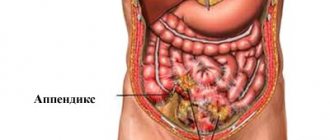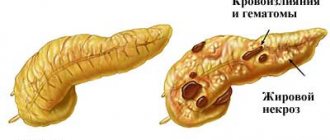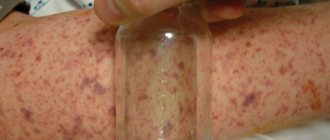Acute appendicitis, or the condition of inflammation of the appendix, is a disease that in 90% of cases is treated with surgery and removal. The removal operation is performed by making an incision in the abdominal cavity, through which the inflamed appendix is penetrated. After such an incision, a scar is left in the patient’s abdomen from the removal of appendicitis. A body with a scar does not look very attractive; sometimes it causes not only aesthetic irritation, but also discomfort and even pain. What a seam looks like on the body, types, whether it is possible to remove the mark completely after appendicitis is discussed in the article.
Scar formation
If the operation to remove the appendix was performed by laparotomy, an incision was made in the peritoneum. Once the removal is complete, the incision is sutured and the body begins to work on reconnecting the destroyed tissue. At this moment, the walls in the incision area begin to become inflamed. This happens for reasons:
- A microbial environment or infection has entered the incision area, at this time the incision mark may hurt, sometimes fester, and ichor is released. During inflammation, the body begins to secrete protective cells, protecting itself from the penetration of pathogenic flora.
- During inflammation, the body produces more collagen, which becomes the basis for scar formation to close the wound.
Inflammation at the incision site continues for about a week or two. For the entire period, it is important for the patient to carefully monitor the condition of the incision, treat it with antiseptic solutions in a timely manner, and ensure that the wound is not exposed to dirt, dust, or sunlight. With proper healing without problems, a small scar remains on the body, it hurts a little at first, and can be bright in color, from red to blue. The scar causes a feeling of discomfort, itching, pain when moving, bending, or pressing. Within a year, in most patients, the incision site heals completely, the skin is restored, and the brightness disappears. A pale, inconspicuous mark 1-10 cm in size, convex in appearance, remains. Pain and discomfort disappear with normal healing.
But not every patient has a smooth scarring process. In women, the incision site heals faster than in men. And the child will generally heal in 2-3 months, since the metabolism is several times higher. Depending on the correctness of healing, care and characteristics of the body, marks after surgery are formed differently and are divided into types.
Patients experience the stage of scarring and restoration of the skin differently. Therefore, the site from the incision during appendicitis surgery appears in each person of a different size and shape, and it takes a different period of time to heal.
- Normotrophic – type of scar: the simplest, pale, invisible. Externally it does not cause irritation, as it does not stand out against the background of the skin. It looks like a thin strip at the incision site, can be corrected, and complete removal is possible using modern methods - laser resurfacing, for example.
- Hypertrophic - the scar is thick, hard, voluminous, rises above the patient’s skin, and is brighter in appearance than the rest of the skin. This type is more difficult to remove. Long-term correction by grinding, therapy with medications, ointments or current treatment can make the surgical site less noticeable.
- Atrophic - unlike hypertrophic, it does not rise, but, on the contrary, sinks into the skin. This happens due to a lack of connective tissue during healing or errors in caring for the incision. To add aesthetics, you will have to raise the seam to the surface. More often this can be done with injections, fillers, cosmetic fillers for skin volume, and hormonal therapy may be required. It is not possible to completely remove it.
- Keloid is an outwardly unattractive, dangerous appearance. It occurs when scarring fails and does not heal for a long time; collagen is released in large volumes and does not stop releasing for a long period. It is difficult to correct, because any manipulation causes complications in the form of additional collagen production and increases in size again. Can remain unchanged for a long time. It looks rough, especially for women who do not have the opportunity to wear open clothes and swimsuits on the beach with such a scar.
Appendicitis scar photo on a guy
The size of the appendicitis scar depends on the operation and the skill of the surgeon. After traditional resection, a 15 cm long scar will remain on the abdomen. After laparoscopy - three punctures in the peritoneum. They heal quickly and leave barely noticeable marks. Appendicitis without a scar is only possible with laparoscopy.
The speed of healing depends on:
- Size of the wound . A large appendicitis scar takes longer to heal than laparoscope punctures.
- Patient's age . In older people, tissue regenerates 20% slower than in young people.
- Complications . Inflammation prevents the wound from healing.
- Tissue regeneration . This is an individual feature of each patient.
The appendicitis scar hurts for the first 2 weeks. Further pain is a sign of complications: infection, suppuration or hernia. Due to complications, the wound heals more slowly. Doctors know of cases where healing lasted 1 year.
Patient after laparoscopy
While the patient is in the hospital, he is cared for daily. The wound is bandaged and the seam is treated with an antiseptic. This is necessary so that the scar after appendicitis does not fester.
You are allowed to go home a week after the operation. After laparoscopy 3 days. But the treatment doesn't end there. An appendicitis scar must be handled with care until it heals. On average it will take a month.
Here are standard recommendations for treatment at home:
- Follow a diet. Eat puree soups, porridge and drink plenty of water. Avoid fatty foods, bad habits and gas-forming foods.
- Do not lift heavy objects.
- Do not wash in the bathtub, sauna or open water.
- Do not tense your abdominal muscles.
- Don't gain weight.
- Do not engage in active sports.
- Treat the edges of the wound after water procedures.
Appendicitis scars take longer to heal in men than in women. This is due to anatomy - the fibers of male muscles are coarser. But the main reasons lie in violation of medical rules.
- Men are more likely to neglect their diet.
- Out of habit, they do not measure the weight of the things they lift.
- They forget to use cosmetics to heal wounds.
After a year, the scar from appendicitis completely heals and cannot be corrected. The only way to get rid of it is to cover the appendicitis scar with a tattoo.
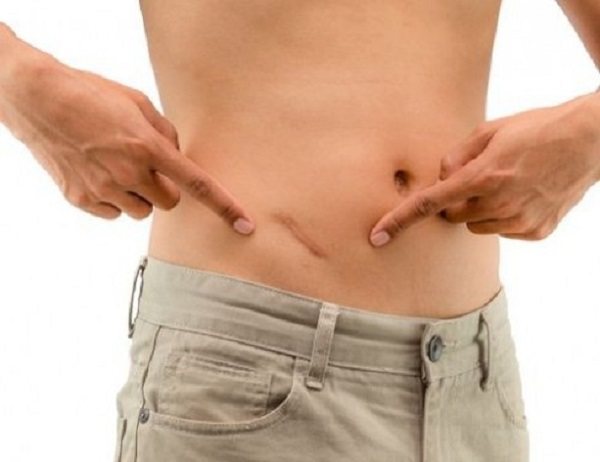
The scar will become smaller if you take care of it
The suture after surgery consists of an outer and an inner layer. The condition of the outer seam depends on the healing of the inner layer. Therefore, you should not load your abdominal muscles. The thin threads of the inner seam are not designed to withstand overload and break easily.
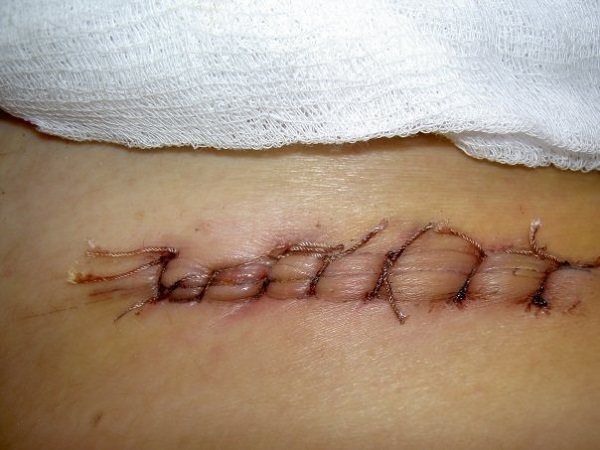
External seam
What a healthy outer seam looks like:
- The size of the scar did not change after surgery or became smaller. Enlargement is a sign of complications.
- The appearance of the scar - a horizontal line with a slight downward slant - has not changed. If the line goes crooked, then the seam spreads.
- Pay attention to the color: after the operation, the wound is purple-red. When healing, it turns pale.
- In the first week after surgery, the scar is dense to the touch. In contrast, scar tissue is delicate and requires care.
- The wound heals within a month. Violation of doctor's recommendations or complications will delay the process.
For treatment, doctors recommend using gentle medications:
- Chlorhexidine.
- Miramistin.
- And hydrogen peroxide.
Pain under an appendicitis scar is the first sign of complications.
Also a signal to seek urgent help is:
- redness of the wound;
- swelling;
- unpleasant odor;
- dark liquid oozing from the seam;
- heat;
- throbbing pain in the right side;
- unbearable itching.
Worrying about the appearance of the scar immediately after surgery is a waste of time. Over time, the scar will smooth out and fade. If you are concerned about the appearance of an ugly scar, then pay attention to correction methods.
A tattoo on an appendicitis scar is a popular solution to disguise the scar. The tattoo is applied a year after the operation. The price of the work depends on the complexity of the design, the experience of the artist and the salon where the tattoo is done.
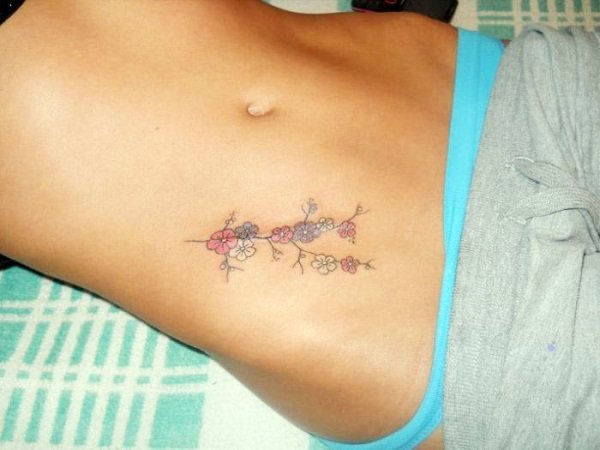
Tattoo on a girl's appendicitis scar, photo
We recommend that you contact only trusted salons and use the services of experienced professionals who comply with hygiene standards in their work.
Pharmacies sell ointments, gels and antiseptics for the treatment and correction of sutures. They soften the density of fibrous tissue and make the scar smaller. In addition, pharmaceutical preparations change the color of the scar from red to flesh-colored.
Don't forget to ask your doctor which products are right for you. There are contraindications due to allergies to components.
When treating a scar with physiotherapy, the following is used:
With these procedures, drugs are introduced into the patient's skin that:
- Fibrin (the basis of the scar) is dissolved.
- Stimulate tissue healing.
- Soften and smooth the top layer of keratinized skin.
Ultrasound is most often used, because it improves the permeability of the skin to drugs. The session lasts on average 5 minutes. The duration of the course is 10 procedures.
Before taking hormonal medications, you need to visit a doctor. If not treated properly, drugs are harmful to health.
Treatment is carried out through local injections directly into the scar tissue. If necessary, an anesthetic - lidocaine or liquid nitrogen - is injected into the skin near the scar.
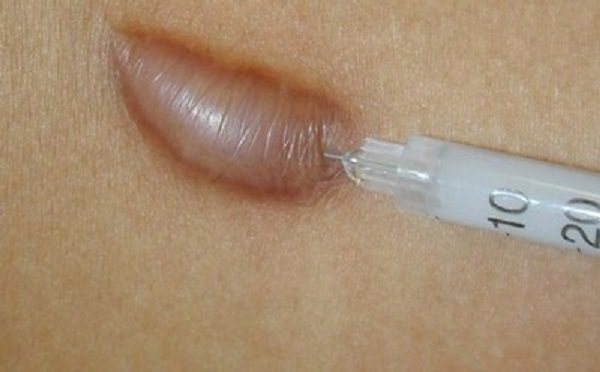
Treatment of appendicitis scar with hormonal drugs
Hormonal therapy is effective against severe, overgrown scars - keloid and hypertrophic. And also to stop adhesions. Side effects from therapy include hyperpigmentation, swelling, seoporosis and gastric ulcers.
The main substance of peeling is acids, which destroy the top layer of skin. After peeling, the skin is treated with special preparations to moisturize and nourish.
A month later the procedure is repeated. The course lasts 3–4 procedures. Deep peeling is contraindicated for people with dark skin because it lightens the top layer.
Contraindicated in pregnancy, infections and fresh wounds. Laser resurfacing is carried out six months after the operation. For the effect, 5-6 procedures are required with an interval of a week to a month (depending on the area of the scar).
After a course of grinding, recovery lasts for a week. At this time, the skin peels off. It is recommended to avoid the sun, not wear synthetics and use healing ointments.
An expensive option with a 100% guarantee of effect. It involves transplanting the top layer of skin to the site of the scar.
It is important to follow your doctor’s advice not only to avoid complications. A gentle diet, minimal stress and caring for the scar will allow the wound to heal and smooth out.
When your appendicitis scar hurts, don't try to get rid of it. Get treatment. See your doctor to find out the cause of your pain.

Only a doctor will determine the cause of the pain
If pregnant, postpone procedures. Otherwise, they will harm the child.
Before you decide to camouflage or correct a scar:
- Check if the wound has healed.
- Make sure there are no complications.
- Don't forget to consult a surgeon or dermatologist.
source
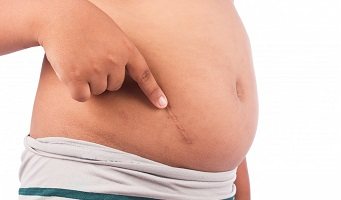
scars , it seems to me, will be companions of surgery for a long time, if not always.
Abdominal operations with tissue dissection are often inevitable. The picture is the same with appendicitis.
Yes, we have now learned how to remove an inflamed appendix using laparoscopy using several punctures.
But in cases of concomitant peritonitis, and even extensive peritonitis, open classical surgery cannot be avoided.
And sometimes it seems almost monstrous to children. And some men today are already beginning to believe that this particular scar does not decorate them in any way.
Let's talk about this problem in more detail.
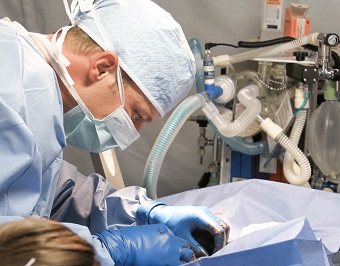
without serious complications, the scar after abdominal surgery measures from 7 to 8 cm.
In cases where the surgeon has to overcome a large fat layer, the incision can reach 20 or even 25 cm.
It is produced in the lower right part of the abdominal cavity with a slight downward slope.
At first the scar is red, then it changes to white. Immediately after surgery, it is hard to the touch, but over time (after a few weeks) it softens.
This is due to the formation of new connective tissue.
In addition to external sutures, which are removed after some time, internal sutures are also applied during appendicitis removal. They are self-resorbable.
If the resorption process is delayed, an inflammatory process may begin, which will inevitably affect the condition of the scar on the patient’s abdominal cavity.
Postoperative scars can be of several types:
- hypertrophic, such consequences are least noticeable;
- regular or retracted, such scars are noticeable, and their correction requires the use of more complex methods;
- too fresh or too old - here the struggle for a spring look can be lengthy.
In general, the type of scar depends on compliance with the physical activity regime, individual metabolism in each organism and its ability to regenerate.
And yet, you may not believe it, but the “appearance” of a scar after appendicitis largely depends on the postoperative diet.
For example, eating foods that cause increased gas production can lead to increased healing time and stretching of adhesions.
This is due to the fact that many representatives of the stronger sex are not used to dosing physical activity.
Plus, it is believed that a man’s skin and muscle tissue is rougher.
In addition, men rarely carefully follow the postoperative diet and neglect cosmetic products that women readily use.
It is advisable to choose products that contain substances of plant and animal origin, for example, fermenkol or contratubes.
The visual effect of their use can occur within a few weeks. But some people have to be patient for several months - this depends on the characteristics of the body and the complexity of the operation.
Let me make a reservation right away: you cannot use these drugs without consulting a doctor and without a thorough diagnosis.
Hormone therapy is really helpful in the early stages of healing, a few weeks after surgery. At a later time, it will only negatively affect the metabolic processes in the body.
There are 2 types of drugs that are injected into the area of scars for the purpose of treating them:
- enzymatic, used to treat hypertrophic and retracted scars, the most effective drug from this group is longidase;
- glucocorticosteroids affect the same groups of scars; Kenalog and Diprospan are most often used.
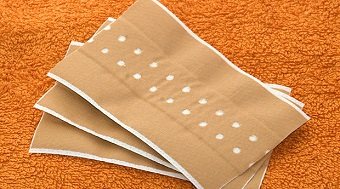
They are divided into silicone and standard types. The patch looks like a small bandage that protects a certain area of the body.
However, to top it off, it is impregnated with a special composition that promotes scar resorption.
The use of this elastic specialized belt stops the excessive development of unwanted connective tissue.
It is convenient because it is easy to use, but does not have a specific effect on the resorption of the suture.
I repeat, this depends on the characteristics of the body, adherence to the regime, dosing of loads.
The process can last from several months to a year.
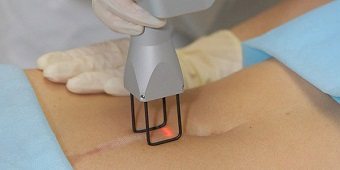
This is widely used in dermacosmetology in many cases, after appendicitis it is used 6 months after surgery.
Thanks to the laser, you can bring the color of the scar to a flesh color in just a few sessions.
It is carried out using abrasive substances. The procedure resembles a large-scale peeling when the top layer of epithelium is removed.
It should be noted that this method of correction can be seriously painful, especially if the technique is poorly adjusted or the master performer is inexperienced.
They are applied at the site of the scar, covering it and even adding beauty to the appearance. Recently, this correction method has become increasingly popular.
Foundations from this group can mask a defect for only a few hours, but sometimes that’s enough. Then such a disguise is usually easily washed off with water.
Sometimes plastic surgery can be used to correct undesirable consequences. This is especially true for old scars that are more than a year old.

Pain in the scar area may occur even several months after surgery.
This may be the result of physical stress, overload, or poor nutrition.
Sometimes inflammation of the scar is a consequence of internal complications after surgery, especially the intestines.
Painkillers and patches, as a rule, only help with physical causes of illness.
In other cases, it is better to consult a doctor and not self-medicate.
As you can see, if desired, the postoperative consequences of changes in appearance can be removed quickly and painlessly.
But it’s hardly worth making this an obsessive goal in your life; sometimes our health has much more serious problems.
source
The scar after appendicitis can have a different size: during abdominal surgery the standard length is from 5 to 10 cm, and after laparoscopy a pair of punctures 1-2 mm long remains. The scar is always located only on the right side, has a horizontal or slightly inclined direction towards the center of the abdomen.
If the wound becomes inflamed during the postoperative period, or if the patient has gained weight, the scar may spread 15 centimeters or more. Healing proceeds differently for everyone; in addition to the skill of the surgeon, the patient’s age and ability to regenerate tissue also matter. In older people, scars from appendicitis removal heal 15-25% slower than in young people, and the likelihood of complications, even with proper care, is 2-3 times higher.
Some girls consider scars unsightly, but the main problem that an appendicitis scar brings is not changes in appearance at all, but itching and pain.
If a week after abdominal surgery there are no indications for extending the hospital stay, the patient is sent home. Before discharge, the scar is cared for by a nurse who antiseptically treats the external suture with diamond green, bandages it, and monitors healing.
After discharge, the patient receives detailed instructions on lifestyle and the specifics of scar treatment. Here are the surgeon’s standard recommendations that contribute to the successful healing of the scar:
- For 2-3 weeks, follow a diet, avoid alcohol, give preference to liquid and mushy foods. Avoid legumes, cabbage, pastries and white bread; these foods provoke the formation of intestinal gas in most people. Bloating often provokes separation of the internal seams, and then inflammation of the external seams begins.
- If constipation occurs after changing the hospital diet to homemade food, then to restore stool, you should drink beetroot juice or use a laxative medicine in the form of a suppository. It is not advisable to push and strain your abdominal muscles.
- Do not lift more than 5 kg in the first week after appendectomy and do not lift more than 10 kg in the next 4 weeks.
- Lubricate the external seam with an antiseptic after taking a shower. Do not take a bath, especially a hot one, for 2 months after discharge. After applying the antiseptic, you need to wait until it dries; you should not immediately get dressed or cover the seam with a bandage.
Engaging in strength training, running or other physical activity that strains the front wall of the abdomen is prohibited.
Advice! If physical work is unavoidable, or if the patient is overweight, wearing a brace is recommended for 1 month after surgery.
The use of aggressive solutions, especially iodine, can lead to chemical burns. As a result, wound healing is poorer and the likelihood of hypertrophic scar formation increases. What antiseptic solutions can be used to sanitize the seam:
- Fukartzin;
- brilliant green;
- hydrogen peroxide.
Usually, upon discharge, the surgeon explains in detail which agents can and cannot be used on a fresh suture. Chlorhexidine digluconate and its analogues are allowed:
Patients using Miramistin and its analogues can obtain excellent healing results:
Contrary to popular prejudice, the formation of a hypertrophic scar is provoked not only by improper care, but also by heredity. If blood relatives heal wounds with the formation of an excessive amount of fibrin, most likely the patient will have a similar process.
Fact! Over time, the scar should align with the surrounding skin and become paler, so there is no need to worry about a cosmetic defect immediately after surgery.
Scar thickening can be avoided by carefully and responsibly monitoring wound healing. In what cases should you contact a surgeon and undergo an examination:
- redness appeared;
- swelling has developed around the wound;
- yellowish or greenish liquid with a foul odor oozes from the wound;
- there is a subjective feeling of increased temperature on the right side of the abdomen;
- there is throbbing pain in the scar area;
- unbearable itching bothers me.
It is believed that normally the scar hurts for no longer than 2 weeks, and the pain is dull and aching in nature. If necessary, you can remove it with painkillers, for example, Nurafen or other medicine recommended by the doctor. If the scar hurts several months or years after the intervention, this is a reason to consult a doctor.
The internal sutures dissolve on their own after 1 week, but to remove the external ones you need to visit a doctor.
Advice! Sharp pain in the first month after appendectomy sometimes signals inflammation of the internal suture. With such a symptom, you need to immediately go to the surgeon.
In agreement with the surgeon, medications can be used to promote rapid and painless healing of the postoperative suture. There are more than 25 similar drugs on sale, which are used most often:
- Contractubex. It has a simple composition, based on heparin. Additional ingredients include onion extract and allantoin. Apply to the seam for a month, 2-3 times a day. Promotes smoothing of scar relief and rapid skin regeneration without the formation of hypertrophic changes. With the help of Contractubex, you can remove not only fresh, but also old scars after appendectomy.
- Strataderm. It has a fundamentally different effect, is based on silicone, softens fibrous tissue and promotes normal collagen synthesis. Treatment takes 2-3 months, the product helps to remove the convex relief of the scar.
- Kelo-cat. The medicine is also based on silicone, it should be used for at least 2 months to get results. Under the influence of the cream, the scar from appendicitis becomes less rigid, pigmentation and relief are normalized faster.
These medications have no contraindications other than allergies; they can be used by nursing women and those who will soon become mothers.
Advice! During scar treatment, you should not visit a solarium or sunbathe; exposure to ultraviolet radiation increases the likelihood of connective tissue hypertrophy.
Aesthetic medicine has in its arsenal many means to restore the attractive appearance of the skin. You can also remove an old appendectomy scar using more radical methods:
- Surgical excision of the scar (cross-resection method) with the application of a cosmetic suture. It is also possible to introduce a certain amount of fatty tissue from another part of the patient’s body into the connective tissue, this will help restore the normal structure of the skin. As a result of the operation, it is possible to completely level out the relief of the scar.
- Electrophoresis with drugs that dissolve fibrin, most often with Fermenkol. During the healing stage, magnetic therapy and ultrasound are also used.
- The most affordable method is laser resurfacing. Allowed for use six months after appendectomy.
- Dermabrasion. Laser removal of connective tissue protruding above the general level of the skin, smoothing the relief.
To disguise the scar, a tattoo is also used on the right side of the abdomen. A tattoo can be done only if the scar has healed without complications and not earlier than a year after surgery.
Before using any method of correction or camouflage, you should consult a specialist (surgeon or dermatologist).
If you find an error, please select a piece of text and press Ctrl+Enter.
We will be very grateful if you rate it and share it on social networks
source
On which side is appendicitis located? This question worries almost everyone who has experienced abdominal pain. Appendicitis is an inflammation of the appendix of the cecum. To avoid possible complications, every person should know where appendicitis (appendix) is located and what symptoms are characteristic of this pathology.
To begin with, it is worth clarifying that the wording itself is not correct. Appendicitis is a disease.
For most people, the site of inflammation is the lower right side of the abdomen, just below the level of the navel. This arrangement is considered the standard and most common.
However, the appendix can be located in other places - this does not depend at all on gender or age. Such cases occur quite rarely, but still the non-standard location of the process of the cecum is the norm.
This feature is most often found in women. Typically, appendicitis in the pelvic location is difficult to diagnose because the symptoms differ significantly from the standard location of the appendix.
In this case, the person is worried about:
- frequent acts of defecation,
- sharp pain in the lower abdomen.
This location is usually called subhepatic.
Pain on the right side, in the upper abdomen. Sometimes - under the ribs, directly under the liver.
| Where is appendicitis located? | Characteristics - where does appendicitis hurt? |
| Sometimes the location of inflammation of appendicitis is in the pelvic area | |
| In medical practice, cases have been recorded when the apex of the appendix was located not downwards, but upwards. | |
| The appendage of the cecum is located in the stomach area | In this case, it is difficult to answer the question on which side the stomach will hurt. The inflammatory process, as a rule, begins with ordinary stomach pain, which is characteristic of gastritis. |
| Often the process of the cecum is located outside the abdominal cavity. | Some patients claim that during inflammation of appendicitis, acute pain was observed in the lumbar region. |
| Less commonly, the location of the appendage is the area behind the cecum or along it. | The pain on the right side is dull and dull in nature. |
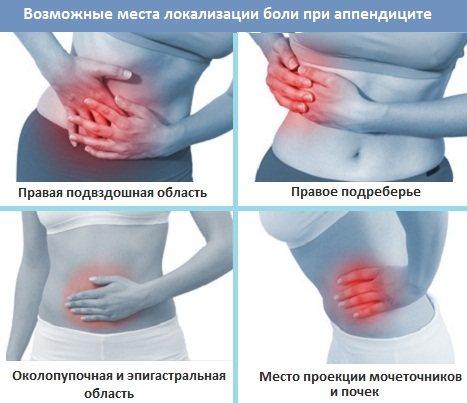
To date, no specific cause for the development of appendicitis has been identified. Possible causes include the presence of pathogenic bacteria and blockage of the lumen of the cecum at the same time.
Appendicitis usually develops regardless of age. Therefore, both children and elderly people can become the owner of an inflamed appendix.
According to statistics, appendicitis is 5% more common in women in an “interesting situation” and in children aged 5 to 8 years.
It should be noted that pathology cannot develop in children under one year of age. This is due to the fact that in them the lymphoid apparatus of the appendix of the cecum is not yet properly developed, and the appendix itself, due to age-related anatomy, is emptied without much difficulty through a special funnel.
The disease can occur in acute or chronic form.
The most common is the acute form , which is characterized by a rapid course of the disease. In this case, immediate surgical intervention is required.
The chronic form is very rare, most often in men. The reason for its occurrence is a complication of acute appendicitis. This form is difficult to diagnose, but if a diagnosis is made, surgical intervention is also necessary.
Depending on the complexity of the pathology, the following types are distinguished:
This type is considered the beginning of the inflammatory process, and only the mucous membrane of the appendix is affected.
The catarrhal type is characterized by mild symptoms and moderate pain, making it very difficult to identify the disease at this stage.
May be fatal. If the pathology was not detected at the phlegmous stage, the process of the cecum dies, the pain subsides, the symptoms disappear, and the inflammation begins to progress.
Pus enters the abdominal cavity, peritonitis develops.
| Variety | How does appendicitis hurt? | Photo |
| Catarrhal | ||
| Surface | The inflammatory process penetrates the tissues, the person is bothered by acute pain. In most cases, appendicitis is diagnosed at this stage. | |
| Phlegmous | This species is characterized by complete damage to the appendix. The appendix of the cecum is filled with pus, there is a very high risk of complications. The symptoms are pronounced. | |
| Gangrenous |
As a rule, the symptoms of this disease develop abruptly. Let's look at how appendicitis hurts in humans:
Photo: Coated tongue
- The main symptom is pain in the navel area. The pain is vague, that is, the person cannot accurately point to the painful place. The pain intensifies with movement. It should be noted that in older people (over 60 years old) pain may not appear.
- Another sign of an inflamed appendix is increased body temperature . Usually it fluctuates in low-grade levels. If we are talking about the gangrenous stage, the temperature can rise to 40 degrees.
- In some cases, a person feels nauseous, a single vomiting is possible (at the level of a reflex), insomnia and loss of appetite.
- A coated tongue is one of the common symptoms.
With an exacerbation of appendicitis, acute pain in the lower abdomen, mainly on the right, is most often tormented. Painful sensations begin abruptly and gradually intensify.
Depending on age or individual characteristics, signs of the disease may vary.
The appendix becomes inflamed most often between the ages of 5 and 8 years.
In childhood, this pathology is very difficult to tolerate, the symptoms are more pronounced, and the inflammatory process proceeds faster. This feature is due to the fact that the child’s body is not able to fully fight infection.
Body temperature is within 38-38.5. The child does not allow you to touch his stomach, he constantly lies and dies with his legs towards his stomach.
As mentioned above, the process of the rectum becomes inflamed much more often during pregnancy. This is due to the fact that it gradually shifts due to the growth of the uterus, as a result of which it is compressed and its blood supply deteriorates.
The second reason is constipation, which often bothers a pregnant woman. Due to constant constipation, the intestinal microflora changes.
Symptoms of appendicitis during pregnancy are not pronounced, the pain is moderate and aching. The temperature ranges from 37 to 37.5.
It is very difficult to diagnose pathology in older people. Often, with inflammation of appendicitis, an adult does not notice any changes in well-being.
Due to the rapid development of the destructive process, older people are worried about nausea and vomiting. Painful sensations occur only with the gangrenous degree of the disease.
Let's consider the complications after appendicitis that occur most often:
| Complication | How does appendicitis hurt during complications? |
| Seam divergence | It is possible for both internal and external seams to diverge. When the internal seams diverge, nausea, vomiting, and deterioration in health are observed. When the external sutures also separate, the wound opens. In some cases, bleeding may occur. |
| Peritonitis | It develops mainly in adults due to late presentation to a medical facility. The complication is manifested by abdominal pain, bloating and high fever. |
| Postoperative hernia | As a rule, it occurs due to divergence of seams. The appearance of a hernia can be caused by trauma in the peritoneum after surgery. |
Unfortunately, today there is no drug treatment for an inflamed appendix. Treatment is carried out exclusively by surgical method. There are two types of surgical interventions:
- Laparotomy . An incision is made in the abdominal cavity and the inflamed appendage is excised.
- Laparoscopic . A small hole (about 1 cm) is made in the abdominal cavity and the necessary removal procedures are performed. Today, this procedure is performed more often.
Most often, surgery to remove appendicitis is performed urgently.
To prevent possible complications after surgery, the doctor prescribes a course of antibacterial drugs. After the operation, you must remain in bed for 10 hours, after which you are allowed to get up and move without sudden movements.
After surgery, it is forbidden to eat food for 24 hours; only boiled water is allowed. After a day, gentle food is gradually introduced: liquid cereals and soups. After another day, they are allowed to eat bread. The diet must be followed for 5-7 days.
After the patient is discharged, physical activity is prohibited, including sex, as this can cause the sutures to come apart.
After surgery, a small scar remains, its size depends on the method of surgery. The scar is located on the lower right side of the abdomen.
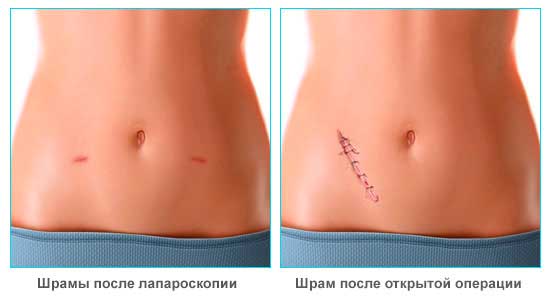
Photo: Scars after appendicitis
To speed up healing, doctors recommend various wound healing creams and ointments. To make the scar less noticeable, some girls get tattoos on the damaged area of the skin.
source
Tattooing is a modern form of body art with the help of which men and women decorate their bodies and express their individuality and originality. However, there are people who use tattoos not only as decoration for their bodies, but also as the only way out of the situation. Tattoos on scars are often the option that restores former attractiveness after injuries or scars. To hide scars and make a beautiful tattoo, you need to choose the right sketch of the design, and also find out whether it is possible to apply a tattoo in principle.
Statistics show that almost every second person has at least one noticeable skin defect on their body. There are many reasons for this: burns, surgical scars, injuries, or a scar from a cesarean section (for some women who gave birth). Modern and popular art of tattooing allows you to mask body irregularities, hiding them behind tattoos, sketches of which can be selected to suit any shape and size of the scar.
At the moment, most often they try to disguise the scar from surgery aimed at removing appendicitis. In order to hide a visible skin mark, first of all you need a sketch of the future tattoo; this can be done even before coming to the artist. It is best to hide scars with floristry, ornaments or tattoos in the animalistic genre. Men, unlike girls, do not always want to cover the scar, so they choose paintings that highlight the scar as a symbol of courage. You can see what the future work will look like by asking the master for his portfolio, which contains photographs of the finished work.
Skin injuries, visible defects and irregularities very often create psychological discomfort, against the background of which girls and men develop complexes. In order to get a tattoo on a scar, you must follow the main rule - the scar must be in the final stages of healing. That is, tattoos cannot be applied to fresh scars; the period from their appearance to tattooing should be about one year.
- Atrophic - outwardly it is a whitish area of skin that is slightly deeper than the general level of the skin. These scars can result from minor burns, cuts, or acne. Atrophic scars also include stretch marks after weight loss or childbirth. Tattooing on atrophic scars is permitted and easily hides the visible defect.
- Normotrophic - appear as a result of small wounds, are located at a general level, do not have swelling and are whitish in color. Tattoos on such scars are easy to make, skin defects are completely hidden.
- Hypertrophic - scars that form after major surgery. Outwardly, these are dark scars with a convex texture; they can be hidden, but this is difficult and expensive.
- Keloids - appear on the body a couple of months after operations, can grow, applying tattoos to this type of scars is prohibited.
- Papillomas or birthmarks. As you know, blood capillaries are hidden under these irregularities, so tattooing on them is strictly prohibited. Any intervention in this area can provoke the growth of cancer cells, so the only acceptable solution is a tattoo that bypasses these areas or includes them as part of the picture.
In order for the procedure of applying a tattoo to problem areas of the skin to be successful, you need to follow some tips. First of all, it is worth remembering that the process of applying a tattoo to the body is considered painful, so you need to take care of relieving pain; for this you can use anesthetic gel and other medications. After applying a tattoo, it must be treated every day with a special antibacterial ointment.
Also, during the healing process of the skin, a crust may form, which is undesirable to tear off; over time, it will fall off on its own. It is recommended to hide scars with a tattoo in the summer, since there is much less clothing on the body and the friction of the tattoo on various materials is significantly reduced.
Features of tattoos that hide skin defects:
- The wound must heal completely, otherwise complications may occur when applying a tattoo, and the design may “slip.”
- When choosing a color scheme, you should give preference to bright tattoos containing 4-5 colors in the sketch; monotonous tattoos are not advisable.
- You can mask unevenness using shadows, highlights and midtones.
- The scar has a broken skin structure, so it is able to absorb a layer of paint.
- In order to check whether a tattoo is suitable, you can get a temporary tattoo, the service life of which is about 3 weeks.
The choice of tattoo depends not only on the type of scar, but also on the part of the body where the problem area of skin is located:
- The stomach - getting a tattoo here is painful, stretch marks may appear, but when choosing a sketch, you can give preference to large drawings and full-fledged compositions. Scars on the stomach are more common in girls, for example, after a cesarean section, so the optimal sketches are: a branch of sakura or roses, feathers or birds sitting on a branch.
- Chest - usually scars after severe cancer operations are located here; scars can be closed with the help of a salamander. If the scars are small, you can hide them with flowers or butterflies.
- Arm – if the scars are extensive, then “sleeves” can be made; for minor injuries, there are no restrictions on the choice of sketches.
- Wrist – to hide defects, you can use the outline of a bracelet, as well as small ornaments or flowers.
- Spine – image of branches, corset (for girls), drawn spine (for men).
- Sides or legs - you can hide visible defects with the help of any tattoo; it can be small in size or completely cover the leg or ribs.
source
Preventative care
The condition of the scar and its appearance depend not only on the progress of the operation and the work of the surgeon, but also on how the patient cares for the scar and spends the rehabilitation period. It is important to monitor and properly care for the scar.
- Refusal of physical activity for 2-3 weeks after removal of the appendix.
- Follow a diet and eat small meals to avoid swelling and divergence of the incision site.
- Quitting alcoholic drinks and smoking.
- A large amount of fluid for tissue restoration and food that does not require long digestion and does not complicate the act of defecation. The process of straining is prohibited.
- Careful care and regular treatment of the seam with antiseptics, washing. The incision wound should always be clean and, if possible, dry.
- Medical treatment of the scar, when the surface needs to be smeared with creams, ointments, and additionally use injections.
Correction
Scars after appendicitis surgery can and should be corrected. But the adjustment depends on the type of scar and the individual characteristics of the patient’s body. Drugs and types of correction are agreed upon with the doctor and are not used independently. Not every type of correction is suitable for a certain type of appendix scar. The main correction methods include:
- Make-up is suitable for owners of a thin and pale scar that does not cause discomfort to the owner. Allows you to change the shade and appearance of the scar. Gives a cosmetic effect.
- Tattoo – suitable for those whose scar is pale or atrophic. Owners use a tattoo on a scar from appendicitis to hide external manifestations and give an aesthetic appearance.
- Dermabrasion is a type of correction that uses chemical or mechanical peels. The procedure involves exfoliating the top layers of skin at the incision, causing the mark to become thinner and paler. After several courses of therapy, the scar becomes thin and pale.
- When the scar is retracted into the skin, regular injection of fillers or adipose tissue is required to lift it. Once the incision mark has risen to a level, other correction methods are used to change the shape and pigmentation.
- Laser grinding. You can resort to resurfacing 6 months after surgery. The procedure will make the color of the scar even and pale, similar to the surface of the skin. In addition, the surface is smoothed. After 4-5 applications, the scar remains pale or disappears from the surface of the skin.
Kinds
Postoperative scars can be of several types:
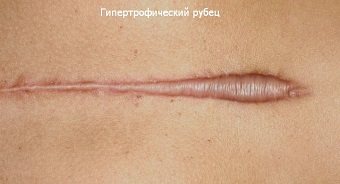
- hypertrophic, such consequences are least noticeable;
- regular or retracted, such scars are noticeable, and their correction requires the use of more complex methods;
- too fresh or too old - here the struggle for a spring look can be lengthy.
In general, the type of scar depends on compliance with the physical activity regime, individual metabolism in each organism and its ability to regenerate.
And yet, you may not believe it, but the “appearance” of a scar after appendicitis largely depends on the postoperative diet.
For example, eating foods that cause increased gas production can lead to increased healing time and stretching of adhesions.
Features in men and women and girls
Interesting fact! As a rule, scar healing occurs more slowly in men than in women.
This is due to the fact that many representatives of the stronger sex are not used to dosing physical activity.
Plus, it is believed that a man’s skin and muscle tissue is rougher.
In addition, men rarely carefully follow the postoperative diet and neglect cosmetic products that women readily use.
What is a scar?
An appendicitis scar is a kind of connective tissue that forms on the human body due to ruptures and loss of the epidermis. This is exactly the tissue that appears after surgery. If the operation was completed without any complications, the length of the scar will be about three to five centimeters. If there are complications during surgery, the size of the scar can even increase to 25 centimeters, but this does not happen very often.

A fresh appendicitis scar usually has a reddish-burgundy hue and may be sore, itchy, and itchy for some time. However, soon the discomfort will disappear and the skin will gradually begin to turn pale. During surgery, doctors make a horizontal incision slightly above the underwear line. However, depending on complications, the location of the incision may change.
The rehabilitation period after the operation is very long and can be about a year.
What are the types of scars?
The type of appendicitis scar depends on many factors. This should include the presence of any complications during surgery, features of tissue fusion, as well as the duration of the recovery period. Depending on this, scars differ. A scar after appendicitis can be:
- A keloid scar that has a smoothed surface.
- Hypertrophic – with pronounced changes in the skin.
- A retracted scar is usually noticeable and may therefore require serious correction methods.
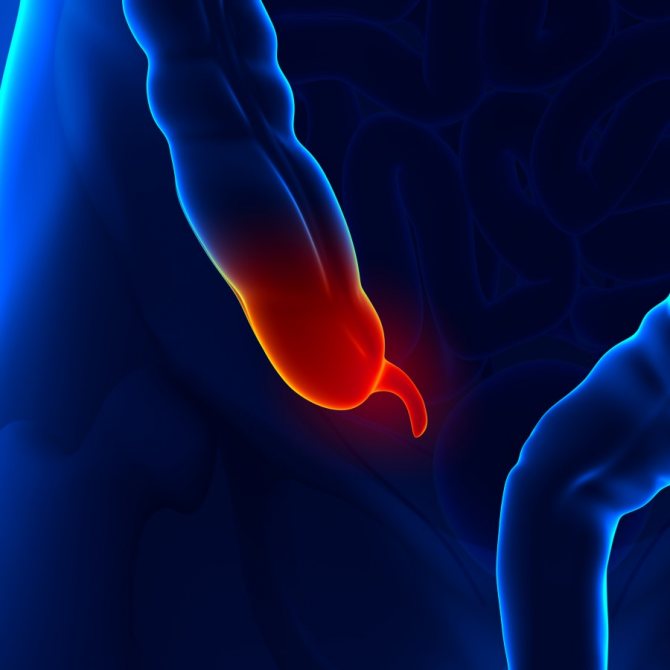
Scars are also classified depending on how long ago the surgery was performed. They can be fresh or old.
Nuances of healing
A surgical scar can take 6-12 months to heal. The painful process of tissue fusion usually occurs in the first days, but it can also drag on. When forming a new dermis, it is necessary to follow safety rules in order to quickly begin correction.
When it hurts
If the scar begins to hurt after a long time, this indicates the onset of adhesive disease or the growth of a keloid scar. In both cases, you should consult a doctor for advice. Normally, the pain should decrease every day.
Much depends on the patient
Of course, the type of appendicitis scar, a photo of which you can see in this article, will largely depend on the patient himself. If a person eats normally, exercises regularly and leads a healthy lifestyle, then metabolic processes in the tissues will proceed much faster, which means the skin will recover faster. The patient must monitor the condition of his scar and, at the slightest deterioration, immediately go to the hospital.
How to care for a fresh scar?
Typically, a week after surgery, the patient is discharged from the hospital. However, if the operation was accompanied by complications, this period may be extended. Of course, while the person is in the hospital, a nurse will carefully care for the scar. She will carry out antiseptic procedures, as well as bandage and monitor the condition of the scar. But as soon as a person goes home, he will have to take care of himself, strictly following all the recommendations that he will be given in a medical institution.
How to relieve and eliminate itching
This is possible, but it is important to do everything correctly so as not to introduce an infection into the wound, cause bleeding or provoke inflammatory processes. Due to the nature of postoperative sutures, it is recommended to discuss each possible method of eliminating itching with your doctor.
Newly placed sutures, through which blood and ichor may still be oozing, require special care. While the patient is in the hospital, it is better to contact the medical staff, who will tell you what to do or offer options for eliminating itching. If there is no help available (the person has been discharged home), you can try applying a cold compress.
Important! The compress is not applied to the wound itself, but to the adjacent skin. Otherwise, the integrity of the seams may be damaged.
A sterile bandage must be placed between the compress and the skin. And if it is ice, which tends to melt, then also a plastic bag so that water does not seep into the wound. About the fifth day after the operation, you can try to soothe the itching with a cold decoction of mint, also wiping only the skin adjacent to the seam with a piece of sterile bandage. The same methods can be used to soothe itching in the area of already formed scars.
Another way to relieve itching is by stroking the adjacent skin. With fresh stitches, this is done with clean hands (fingers), and the scars can be stroked, for example, with a cotton pad or a piece of bandage.
What to do at home?
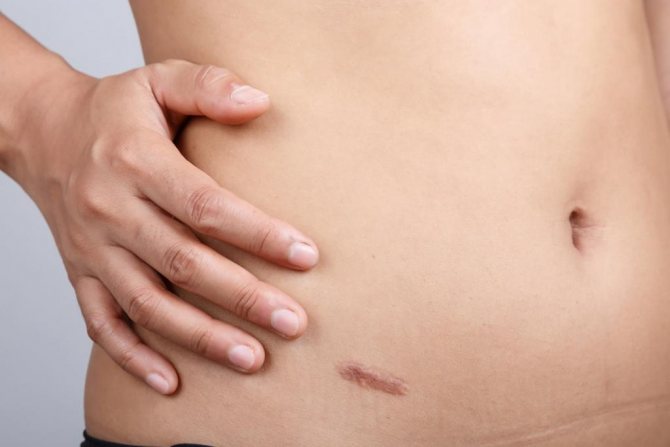
Let's look at how to care for an appendicitis scar after surgery:
- For the first two to three weeks, it is very important to follow a strict diet, eating only liquid and porridge-like foods. It is very important to completely exclude baked goods, cabbage and legumes from your diet, as these foods cause severe gas formation. Abdominal bloating can lead to rupture of not only internal but also external scars, which will cause inflammation.
- If, after you switched from hospital food to homemade food, you begin to experience constipation, doctors recommend taking laxatives. However, it is best if they are in the form of suppositories for rectal use. In no case should you push, straining your abdominal muscles, as this can also lead to rupture of the scar.
- In the first week after the operation, do not lift anything heavier than five kilograms, and in the next month - nothing heavier than ten kilograms.
- It is also very important to take care of the scar itself. After showering, be sure to use an antiseptic as recommended by your doctor. Never take a warm bath for six to ten days after leaving the hospital. After applying the antiseptic, wait until it dries. And only apply a bandage to the dry scar and get dressed.
- Under no circumstances should you perform physical exercises that will strain your abdominal muscles. This also includes running. However, if physical activity is unavoidable, be sure to use a support bandage.
Suture after appendicitis: features of healing and care
The extent to which the suture after appendicitis will remain small and neat often worries patients and especially female patients.
Appendectomy is a type of surgery that is usually performed as an emergency. Health care providers usually do not have much time to prepare the patient. At the same time, this is one of the simplest operations, especially if the patient seeks help in a timely manner.
The type of postoperative suture largely depends on the patient’s health status before surgery and the degree of his diligence in following medical recommendations afterward.
How to make a scar invisible after appendicitis surgery
There is no more effective way than surgical removal for inflammation of the appendix. Removing the appendix is not difficult for a doctor, but people have fears before the operation; they are worried, especially young girls, whether a scar will remain after appendicitis and whether complications may arise. In medicine, there are two methods of removal:
- classic dissection;
- by laparoscopy.
After removal of appendicitis in the traditional way, internal and external sutures remain, and what the external scar will be like in the future depends on the qualifications of the doctor and the patient’s compliance with the rules. During laparoscopy, the external incision, which is a few millimeters long, is practically invisible.
But the appendix is more often removed in the traditional way. Internal sutures are applied using a special thread, which dissolves on its own after some time.
The external wound is held together with a strong thread, and often its healing process depends on how well the internal scars heal.
Conditions for normal scar contraction after appendicitis
The patient remains in the hospital until everything goes well with the external suture, and the doctor decides to remove the threads. The scar from appendicitis initially has a purple tint, but over time, with proper care, it fades and is almost invisible. The sutures are usually removed ten days after the operation, and if the appendectomy was completed without complications, the patient is discharged home.
How to treat a scar at home
The suture after appendicitis continues to be lubricated with antiseptic agents for another month or more. What do we have to do:
- at first, take only a warm shower (sauna, steam bath are excluded, so that the stitches after appendicitis do not become excessively wet);
- limit physical activity from 4 to 6 weeks (simple exercises with gradually increasing complexity of movements are allowed);
- the diet should contain more plant foods (it promotes stable intestinal function, due to which the sutures heal faster);
- Doctors also advise wearing a medical bandage in the first weeks.
If you follow all the recommendations, after a while a slight itching appears between the stitches, this indicates that healing is proceeding normally, but for some it can last about a year.
When are the stitches removed?
The normal time frame for removing sutures after appendectomy is 7-10 days. The main factor determining how long it takes to remove sutures after appendicitis is the state of wound healing. Its speed depends on the degree of surgical intervention, the age of the patient, the general condition of his body and how accurately he follows medical instructions.
The healing of the suture is indicated by the presence of a healthy “crust” (granulation). If the sutures are the same color and do not have seals, nodules, swelling or other complications, they are removed in the manipulation room.
Many patients are concerned about whether it is painful to remove stitches after appendicitis. You should not be afraid of this procedure. It lasts a few minutes and is usually well tolerated by patients. The feeling of skin tightening is not pleasant, but there is no sharp pain.
After the stitches are removed, the patient is discharged for home rehabilitation. During this period, it is important to follow a gentle regimen. Excessive stress or careless movements can cause even well-healed wound edges to separate.
Complete tissue regeneration after cutting and stitching lasts up to six months on average.
Ways to speed up healing
Immediately after the operation, specialists deal with the treatment of the suture. Dressing is done twice a day and consists of removing the old bandage, treating with hydrogen peroxide, an antiseptic (to prevent infection) and applying a new bandage.
Upon discharge from the hospital, the patient, among the medical instructions from the surgeon, receives recommendations on how to smear the suture after appendicitis. Proper treatment of sutures is very important so that the scar after surgery remains as invisible as possible.
Levomekol, all ointments containing panthenol and milk thistle oil have a regenerating and anti-inflammatory effect.
For the first time after surgery, you should not visit beaches and solariums, so as not to expose the scar to ultraviolet rays. In order not to disrupt the healing process of the suture, in the first two weeks it is recommended not to take a bath, but to replace it with a shower. After the water procedure, it is necessary to treat the seam with a 5% iodine solution or a weak solution of potassium permanganate.
The underwear should be cotton and non-pressure.
How to speed up the scar healing process
Patients who flawlessly follow all medical instructions after appendicitis removal usually do not experience negative consequences. The seam gradually acquires a beautiful appearance, and it becomes almost invisible.
Some seek to speed up the recovery process and use additional products to significantly speed up the healing of sutures.
They use sea buckthorn oil or milk thistle; doctors recommend applying Levomekol ointment or other medications.
Many people do not like the postoperative scar after the stitches are removed, and then they try to treat it with gels and ointments for several months.
The product for external use Strataderm contains the latest silicone compound and is specially designed for the treatment of post-operative scars.
By forming a thin moisture-proof film on the surface of the skin, the gel allows it to breathe and protects the injured surface from infection and other negative environmental factors.
Source: https://hospitalvv.ru/zhkt-zabolevaniya/shram-posle-appendicita.html
The safest antiseptics
An appendicitis scar on your abdomen will heal much faster if your doctor can give you the right antiseptic medications. Using harsh drugs such as iodine can only make the situation worse, leading to chemical burns. In this case, the likelihood of developing a large, unsightly scar increases significantly. Let's consider what antiseptics are best to use in order not to harm damaged skin and speed up healing:
- hydrogen peroxide;
- fucorcin solution;
- brilliant green.
It is also recommended to treat a fresh scar with Hexicon or Amident. And for speedy healing, you can use medications such as Okomistin and Solcoseryl.

Please note that the scar will not smooth out and fade immediately, so you should not worry about the presence of a defect immediately after surgery.
How can you remove an old scar?
It is not easy to remove a girl’s appendicitis scar, but it is still possible if you put effort and effort into it.

So, there are several methods to do this, namely:
- Surgical removal of a scar using a cosmetic suture. You can also inject a certain amount of fatty tissue into the connective tissue, which is taken from other parts of the patient’s body. This will help give the skin a normal structure. Thanks to this procedure, it is possible to completely even out the relief of the epidermis.
- A good result can be achieved using electrophoresis with drugs that dissolve fibrin. During healing, you can also use ultrasound, which accelerates metabolic processes in damaged tissue.
- Laser resurfacing is considered the most effective and fastest method. People resort to her help within six months after surgery.
- With the help of dermabrasion, you can give a smooth texture to the skin.
As you can see, there are many methods to remove appendicitis scars. Your doctor will tell you which method is right for you.
Tattoo on stretch marks
After childbirth, or a sudden change in body weight, women's skin becomes covered with unsightly marks, which are commonly called stretch marks. However, men also have such problems. This is an atrophic type of scars on the skin that occurs due to prolonged stretching of the skin area, due to hormonal disorders. Like a regular scar, a striae consists of connective tissue, and therefore differs in color from the surrounding areas of the skin.
In such cases, a neat and beautiful tattoo allows you to hide this defect, and to draw attention not to the defect, but to a stylish and beautiful pattern on the body.
Tattoo on a girl's stretch marks in the form of flowers
Tattoo as a method of covering a scar
A tattoo on an appendicitis scar will not only help hide such an unwanted scar, but will also generally give your body a special grace. Doctors recommend resorting to such a procedure only a year after surgery, and only if the patient does not experience any complications. Before getting a tattoo, you should always consult a doctor.
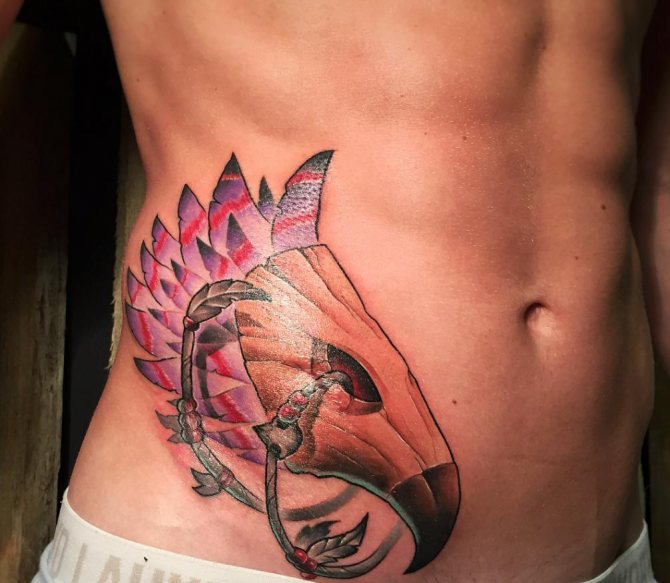
Experts recommend getting colored tattoos, as they will help disguise the scar to a greater extent. In this case, painting a scar must take place in several stages, since it is much more difficult to paint over connective tissue than epidermal tissue.
If you decide to get a tattoo, contact only an experienced tattoo artist, since this procedure must be carried out with special sterility. By doing a tattoo yourself at home, you can get an infection, which will further complicate your situation.
conclusions
Of course, surgery to remove appendicitis is not such a pleasant procedure, and it also leaves scars. Under no circumstances should you be upset about this. In order for the healing process to occur as quickly as possible, it is very important to follow all the doctor’s recommendations and do everything possible to eliminate the risk of complications.

There are a large number of methods on how to remove such a hated scar. You can use laser, dermabrasion, surgery and other methods. You can also apply a tattoo to the damaged area. A professional master will do this so that the scar from appendicitis will be completely invisible, and you will have a special highlight.
Do not forget that any disease is much easier to prevent than to treat. The same applies to appendicitis. Lead a healthy lifestyle, and then the likelihood of surgical intervention will be as low as possible. Take care of your health and take care of yourself!
Based on statistics, it is known that every tenth person undergoes surgery to remove the appendix. Appendectomy is considered one of the most common surgical interventions. Appendicitis becomes inflamed regardless of the gender or age of the patient. The operation is carried out in two ways - by abdominal cutting of tissue and using laparoscopy. In both cases, scars remain on the patient’s body, which for some bring serious aesthetic discomfort. In addition, the area after surgery is sometimes itchy and painful. There are several recommendations and ways to make an appendicitis scar less noticeable.
Scar after appendicitis. Healing, care, correction
Recently, more and more often we hear about the desire of former patients to correct the scar after an appendectomy. The statistics are inexorable: three quarters of those operated on are young people under 35 years of age.
Medical technologies are constantly evolving, and now the process of getting rid of skin defects is not a problem. For some, getting rid of a scar is an urgent need, since this is required by their profession, for others, simply for aesthetic reasons, they want to have a beautiful body, and for some, it is a matter of further maintaining health.
The restoration of the skin in the first week after surgery is characterized by the process of epithelization of the injured surface, and only after a week do collagen and elastin fibers gradually begin to form a future scar.
For the first 3-4 weeks, the suture is dense, red, and sometimes bluish. Over the next three months, the scar fades and becomes flatter. The skin at the scar site will never be the same as it was before surgery.
During postoperative treatment, it is clearly visible how tissue healing is progressing and whether there are any inflammatory processes. But only a surgeon can predict how long the suture healing process will take.
This is due to the progress of the operation, the state of health, age, and even weight. For some patients, this period may last up to a year.
There are four types of scars. Completely flat normotrophic scar
does not cause any inconvenience.
The situation is more complicated with hypertrophic scars
: rising above the surface of the skin, they can be injured while swimming or wearing uncomfortable underwear. Sometimes, after one and a half to two years, such scars gradually smooth out.
Rapid proliferation of connective tissue leads to the formation of a painful, ugly keloid scar
, the mass of which gradually increases. Some experts believe that the formation of such a scar indicates concomitant adhesive processes and serious disorders in the immune system.
Past inflammation and poor nutrition can contribute to a decrease in collagen synthesis. In this case, the body’s resources are only sufficient for an atrophic scar
, the weak surface tissue of which sinks below the general level of the skin.
Due to the fact that men's skin is a third thicker and denser than women's, and contains almost 20% more collagen, scars in the stronger half of humanity actually heal faster. This happens due to high levels of testosterone.
Among most people, there is an opinion that scars and cicatrices do not need to be taken care of; ordinary hygiene procedures are sufficient. Actually this is not true. A newly forming scar requires gentle therapeutic treatment.
- It is important not to miss the moment when the scabs come off from a fresh scar and young pink skin is exposed! Care during this period will ensure the appearance of an even, normotrophic scar.
- Irritating factors must be kept to a minimum: no hard washcloths or inserts on underwear! No rubbing with alcohol or hot compresses! To protect against external influences, a silicone patch Mepiform and Dermatix-gel are applied to the scar, which significantly reduce pain and itching, and also prevent improper formation of the scar.
- Remember: the less often the surface of the scar experiences stretching, the more orderly the fibroblasts will line up, ensuring a uniform structure of the seam.
- Do not forget about such products as Contractubex, Mederma, Strataderm. They can be easily rubbed in, and thanks to combined use with ultraphonophoresis, the active ingredients will penetrate more deeply, tissue micromassage will be achieved and blood circulation will improve. It is advisable to carry out such treatment in courses of 10 to 15 procedures of 7 minutes each over several months. All external products should be used for at least six months. Creams should be applied 2-3 times a day.
- Wearing an elastic bandage to support internal organs will relieve the patient from stretching the postoperative suture and discomfort during movement. The formation of dense scars and adhesions will be minimized.
We have already figured out above that the external suture after appendectomy is not only a cosmetic problem. It should be recalled once again: the younger the scar, the fresher it is, the more successful the manipulations to correct it will be, but today there are a number of effective methods for working with mature scars older than six months.
- Drug treatment. Steroid drugs are injected into the scar. Under their influence, fibrin gradually softens and breaks down. In some clinics, immunosuppressants are used to reduce fibrin synthesis; Thus, the scar can be removed at the initial stage of scar tissue formation.
- Surgical excision of the scar is advisable for scars that are not very wide with moving edges.
- Dermabrasion is the mechanical removal of excess connective tissue from the surface of the scar. This definition speaks for itself. The grinding procedure is quite painful and is performed with anesthesia. The principle is as follows: after treatment with the instrument, local bleeding appears, and later a scab forms. After some time, after the scab peels off, young pink skin remains. The method is time-consuming, and as a complication, the patient may experience the opposite effect.
- I would like to highlight dermabrasion with an erbium laser in a separate section - a method with a minimum number of contraindications, which allows you to make a small scar almost invisible.
- Cryodestruction with liquid nitrogen provokes an immediate spasm of blood vessels in the tissues around the scar and destruction of scar cells, and, according to some experts, activates healing.
- Laser therapy is a popular and relatively inexpensive method. There are contraindications for patients with keloid scars; there is a risk that the scar will begin to grow after exposure to laser radiation.
- X-ray irradiation is also used to remove fibrous formation. But in a quarter of patients, after this procedure, redness remains, which is difficult to get rid of.
Unfortunately, the patient cannot independently choose one of the procedures. The last word will remain with the specialist. Only after a series of tests and analyzes to identify contraindications will a decision be made on the method of getting rid of the scar.
If you suffer from skin diseases, diabetes, lupus, blood diseases, or are a carrier of hepatitis, most of the methods described are not for you.
Important
:
a change in the shape of the scar, redness, the appearance of sharp or nagging pain - these are reasons to immediately contact a specialist
. Moreover, if pus has begun to leak from under the surface!
Pain in mature postoperative scars indicates the onset of adhesive disease. Another significant cause of discomfort in the scar area may be the external growth of a keloid scar.
For more detailed advice on this issue, you should contact your doctor.
HEALTH TO ALL!
Website photo used: https://life4well.ru/
Source: https://zen.yandex.ru/media/id/5a720c6a8139bac94b1f8937/shram-posle-appendicita-zajivlenie-uhod-korrekciia—5b1d0b51bce67ee9778d5d14
How to promote healing of a suture after an appendectomy
The post-operative scar is delicate and requires attention. By caring for and monitoring him during the rehabilitation period, you can prevent various complications and other health problems. It is important to know that if there is severe pain, itching, or the presence of strange discharge from the scar, you should immediately notify your doctor. Such symptoms may indicate serious problems, such as tissue infection or dehiscence of internal seams.
With proper care and as a result of the correct actions of the surgeon during surgery, healing occurs quickly. For 7-10 days, the scar after appendicitis should be treated with antiseptic drugs. For these purposes, you can use alcohol, iodine, and hydrogen peroxide. The treated seam is dried, after which an antiseptic bandage is applied to it, which prevents infection.
Modern methods of scar removal
In the arsenal of modern medicine there are many methods for removing scars. How to remove a scar from the appendix, it is better to consult a specialist. Of the radical methods that help remove old scar after appendectomy, the following are most often used:
- Laser remodeling, also known as dermabrasion, is considered one of the popular correction methods. It involves removing the scar using a laser. In this way, the protruding skin is excised and the relief is leveled.
- Surgical plastic surgery is performed by introducing into the connective tissue a certain amount of fatty tissue extracted from another part of the human body. With this, the normal structure of the skin is restored, the scar is completely leveled and becomes invisible.
- Physiotherapy is done using electrophoresis and Fermenkol gel. This helps speed up the process of scar resorption.
- The most affordable method is laser resurfacing. Its use is permitted after 6 months after surgery.
Why does a scar, suture, scar after surgery itch?
Human skin has the ability to regenerate. This occurs through the formation of scar tissue, which causes itching. When a person is simply scratched, the scar that forms over time is microscopic, but he still wants to scratch or touch the wound. In case of significant violations of the integrity of the skin, in particular after operations, the scar is larger and more noticeable, and therefore the itching is stronger and more noticeable. The process of regeneration of skin and nerve endings is one of the reasons why the wound itches when it heals.
If the stitches have already been removed, but the wound continues to itch, the reason may lie in an accidentally left thread. Fragments of suture materials begin to rot and decompose over time, causing itching. This can be determined by severe redness of the skin around the scar or by developing inflammation in the form of a newly formed wound.
By the way! Itching and inflammation are provoked not only by the suture material, but also by particles of dirt and sweat. Therefore, you need to maintain hygiene, carefully care for the sutures after surgery, adhering to the doctor’s recommendations regarding the external medications used.
If the operation took place more than 6 months ago, and the dense “old” scar formed at the site of the suture is itchy, then the reason may be its dryness. The skin of old scars is quite thin and easily tightens, so it itches. This is especially true during the cold season.
Tips for healing a seam at home
In modern pharmaceuticals there are many auxiliary means for rapid healing and prevention of the development of the inflammatory process. They are produced in the form of ointments and gels. Of these, the most commonly used drugs are:
In this case, folk recipes are also considered effective. The appendix scar is lubricated with milk thistle or sea buckthorn oil. In the first months, it is advisable to use the listed methods and means of treatment daily. This will help achieve quick healing of the scar.

